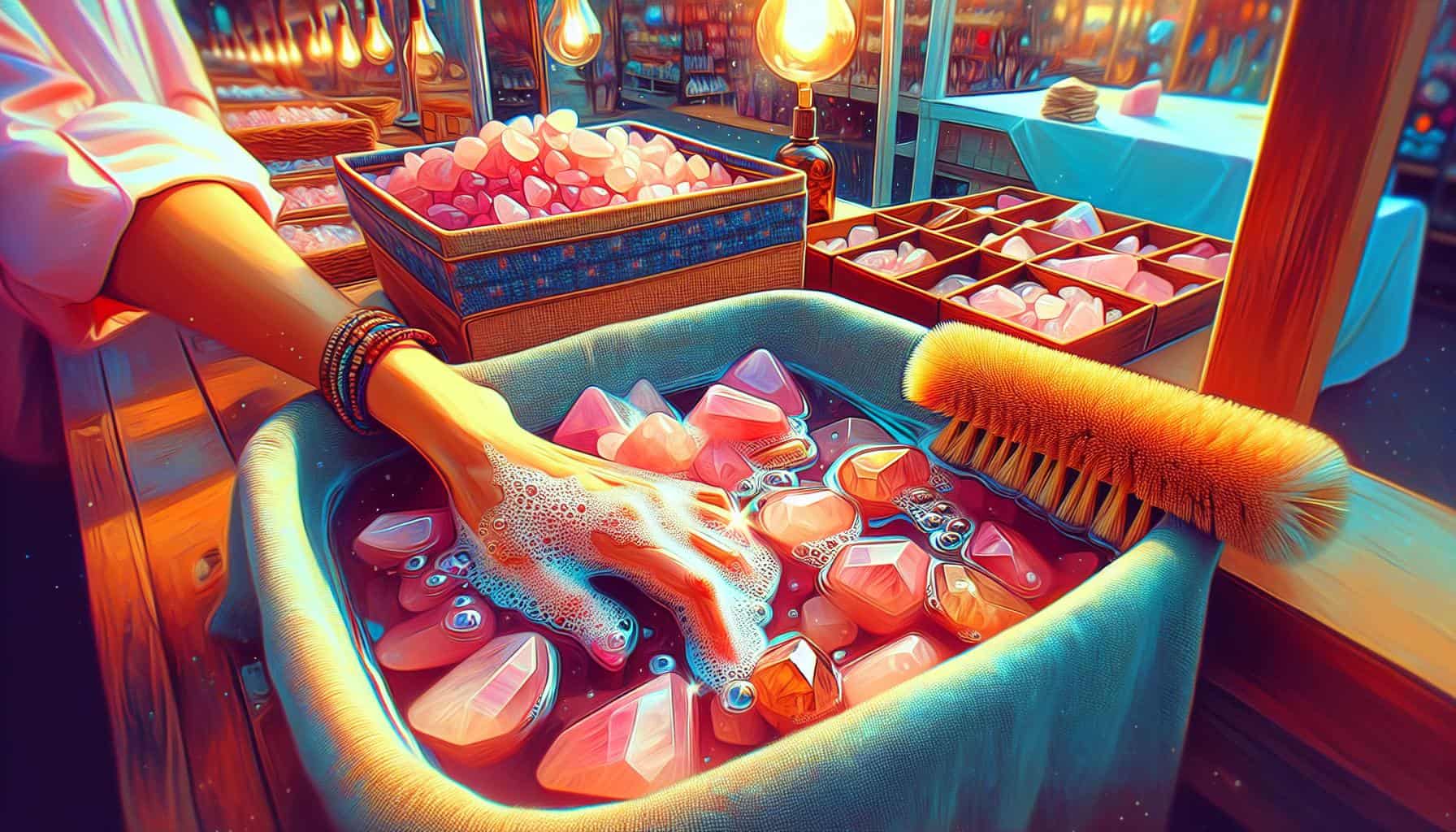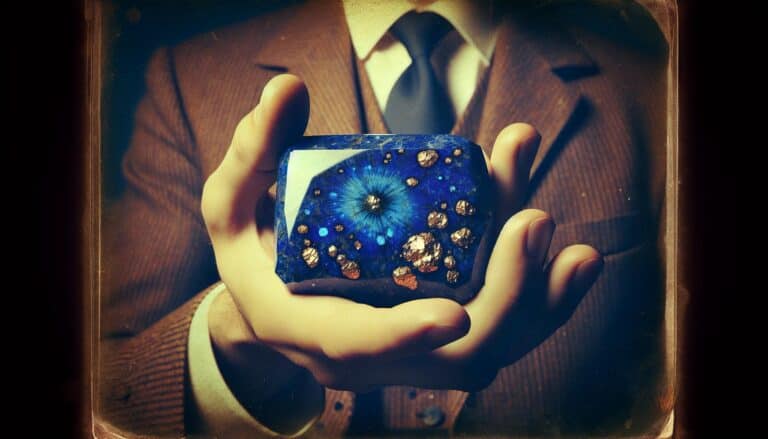You’ve likely come across the subtle allure of rose quartz, with its soft pink hue symbolizing love and healing.
But how can you be sure you’ve got the real deal in your hands? Identifying genuine rose quartz is key to ensuring you’re reaping the benefits of this beloved stone.
From jewelry to home decor, rose quartz has made its mark. But before you add to your collection, let’s dive into the tell-tale signs that distinguish authentic rose quartz from imitators.
It’s easier than you think, and you’ll soon become a savvy selector of this serene gemstone.
To identify genuine rose quartz, look for its soft pink color and vitreous luster. It should leave a white streak on unglazed porcelain, be non-magnetic, and rank 7 on the Mohs scale. Rose quartz is typically translucent, non-birefringent, with a refractive index of 1.544-1.553 and specific gravity of 2.63-2.65.
How to Identify Rose Quartz Through Testing
Visual Inspection
When you’re trying to identify rose quartz, your first step should be a thorough visual inspection. Look for a delicate pink color that’s often considered the hallmark of rose quartz. The hue can range from a very light, almost imperceptible pink, to a rich translucent rose. Check for any inconsistencies or color zoning as it might indicate a synthetic or treated stone. Rose quartz should also typically exhibit a vitreous, glass-like luster when polished.
The Streak Test
A streak test can help you determine the actual color of the mineral. Scratch the specimen over a piece of unglazed porcelain, known as a streak plate. True rose quartz will leave a white streak behind, indicating its inherent colorless nature despite its pink appearance.
Magnet Test
Performing a magnet test is a quick way to check if the rose quartz has been adulterated with materials that have magnetic properties. Gently hover a strong magnet over the stone. If it’s attracted to the magnet, it’s likely that the rose quartz is not pure.
Hardness Test
The Mohs scale of mineral hardness is a useful tool for identifying rose quartz. Rose quartz’s hardness rating is typically around 7. Use a steel file to scratch the surface. If it leaves a mark, the stone in question may not be genuine rose quartz, as a mineral with a hardness of 7 would be resistant to scratches by materials of lesser hardness.
Birefringence Test
Birefringence refers to the double refraction of light within a mineral, causing it to split into two rays. For rose quartz, the birefringence is noticeably weak and may not be easily seen without professional tools. However, distinct or strong birefringence can be a clear indication that the stone isn’t rose quartz.
Checking The Diaphaneity
Diaphaneity, or the transparency of the crystal, in rose quartz can vary. It’s typically translucent to opaque. If the crystal is too transparent, it might not be authentic rose quartz. Be cautious of stones that allow too much light to pass through.
Single or Double Refraction
Rose quartz exhibits single refraction due to its crystalline structure. If you observe double refraction, where the back edges of the crystal appear doubled when viewed through the front, the stone you are looking at is likely not rose quartz.
Refractive Index Test
Using a refractometer can measure the refractive index of the rose quartz. Rose quartz has a refractive index in the range of 1.544 to 1.553. Numbers significantly out of this range may suggest a different mineral or a synthetic substitute.
Finding The Specific Gravity
The specific gravity of rose quartz is typically between 2.63 and 2.65. Testing for specific gravity involves weighing the stone in air and then suspended in water. Calculations based on the weight difference can confirm if the density aligns with that of genuine rose quartz.
Identifying Rose Quartz in the Field
When hunting for rose quartz in the field, look for locations known to have pegmatites, as rose quartz commonly forms in these environments. Large, well-formed crystals are rare, so finding them in their natural matrix can be a strong indication of authenticity.
Recognizing Potential Rose Quartz Rocks
In raw form, rose quartz rocks can look like any other stone. Yet, upon closer inspection, its signature pink hue shines through, especially when wet. Potential rose quartz rocks will have a granular, sugary texture, unlike smoother quartz varieties. Always be mindful of the context in which you find these rocks; rose quartz is often found alongside other quartz types in igneous and metamorphic rock formations.
Physical Characteristics of Rose Quartz

Understanding the physical properties of rose quartz is key to identifying this cherished stone. Color is your first cue. Genuine rose quartz typically displays a pale pink to rose-red hue. This is due to trace amounts of titanium, iron, or manganese. Compared to other varieties, rose quartz has a unique translucent to an almost opaque quality that stands out when you know what to look for.
In terms of hardness, rose quartz sits at about 7 on the Mohs hardness scale. This makes it durable enough to resist scratches from materials like copper but not as hard as the likes of diamonds or topaz. Its crystal system generally forms in masses, making well-defined crystals a rarity. When you’re handling rose quartz, look for a lack of cleavage—this means the stone won’t break along specific planes.
The texture of polished rose quartz is smooth and glassy, while unpolished specimens may feel more granular. If you’re gauging the stone’s lustre, it should appear vitreous to pearly. Remember, these characteristics all contribute to verifying the authenticity of rose quartz before purchasing or adding it to your collection.
Assessing the diaphaneity, or how light transmits through the stone, offers further insight. Rose quartz can range from transparent to translucent, with the latter more commonly found. Expose the gem to light and observe; the more uniform the light diffusion, the higher the quality.
How Are Rose Quartz Formed?
Rose quartz formation involves a remarkable interplay of natural elements and geological processes. Deep within the Earth’s crust, silica-rich solutions cool down, allowing pink varieties of quartz to crystallize. The characteristic pink color is attributed to trace amounts of titanium, iron, or manganese.
High temperatures and pressure conditions are crucial for the formation of rose quartz. Over thousands or even millions of years, these gemstones grow in pegmatites, which are igneous rocks formed during the final stages of magma cooling. The unique conditions within these pegmatites allow crystal growth to an exceptional size, paving the way for large rose quartz formations.
The distinctive coloring of rose quartz comes from fibrous inclusions of a mineral known as dumortierite. These microscopic fibers are usually oriented randomly throughout the stone, contributing to its cloudy or milky appearance, especially in more translucent specimens.
While mining for rose quartz, you’ll often find the gemstone in clusters within pegmatite cavities, alongside other minerals like mica and feldspar. These companion minerals can sometimes influence the quality and clarity of rose quartz, so it’s important to check for these when examining potential pieces for your collection.
Preparation for Rose Quartz Hunting
When you’re getting ready to hunt for rose quartz, preparation is key. You’ll want to assemble the right tools and equipment to ensure your search is not only successful but safe. Keep in mind the characteristics of rose quartz, its formation, and the environments where you’re most likely to find it.
Gathering the Right Tools
Before heading out on your rose quartz adventure, you’ll need to gather a selection of tools to help you efficiently locate and extract the stones.
- Rock Hammer: An essential for any gem hunting expedition, used for breaking rocks and extracting minerals.
- Chisels and Pickaxes: Vital for removing rose quartz from host rocks.
- Safety Goggles: Always protect your eyes from flying debris.
- Gloves: Tough and durable gloves to shield your hands.
- Bucket or Bag: To carry your rose quartz finds.
- Field Guide: Helps in identifying rose quartz and other minerals in the area.
- Map or GPS: For navigating remote hunting locations.
Carrying the right tools can make the difference between a fruitful search and coming home empty-handed. Ensure your equipment is in good condition before setting out.
Safety Considerations
While the allure of discovering rose quartz is exciting, your safety should always come first. Here are some safety considerations to keep in mind:
- Wear Protective Gear: In addition to goggles and gloves, consider steel-toe boots and a hard hat, especially in rocky areas.
- Be Aware of the Terrain: Steep slopes, loose rocks, and slippery surfaces can be dangerous.
- Stay Hydrated: Always carry enough water, particularly in hot environments.
- Let Someone Know: Before you leave, tell someone where you’re going and when you plan to return.
- Watch the Weather: Sudden changes in weather can pose unexpected risks.
- First Aid Kit: Always have a basic first aid kit on hand for minor injuries.
- Know the Local Laws: Be aware of the legalities of collecting minerals on public and private lands to avoid any legal issues.
With the proper preparation and a focus on safety, you’re well on your way to potentially finding rose quartz in its natural setting. Remember to respect the environment and leave no trace of your visit behind.
Handling and Care of Found Rose Quartz

Cleaning Rose Quartz
Once you’ve carefully extracted rose quartz from its natural environment, it’s essential to clean them to reveal their true luster. Start by removing any dirt or debris with a soft brush. If the stones are heavily soiled, soak them in warm soapy water before gently scrubbing. Rinse the rose quartz thoroughly with clean water to remove any soap residue.
For tougher stains, a mixture of water and oxalic acid can be used. It’s vital to handle chemicals with care:
- Use gloves and eyewear
- Follow the manufacturer’s instructions
- Ensure proper ventilation
After cleaning, pat the rose quartz dry with a soft cloth.
Storing Rose Quartz
Proper storage is key to maintaining the quality of your rose quartz. Wrap each piece in a soft cloth or place them in a fabric-lined box to prevent scratching. Avoid storing rose quartz in direct sunlight, as prolonged exposure can cause fading. Also, keep your stones in a cool, dry place to prevent any potential damage from humidity.
If you’re planning to display your rose quartz, consider:
- Using a display case that protects from dust
- Avoiding places with high foot traffic to reduce the risk of accidental knocks
- Positioning away from windows to minimize sun exposure
Remember, rose quartz is a durable stone, but it still requires gentle handling to keep it in pristine condition.
Conclusion: Confirming Rose Quartz is Real
You’ve now got the know-how to identify and care for your rose quartz.
Remember, gentle cleaning and careful storage are key to preserving the stone’s natural beauty. By avoiding harsh chemicals and direct sunlight, you’ll ensure your rose quartz remains a stunning addition to your collection. Whether you’re a seasoned collector or a curious newcomer, these tips will help you enjoy the unique qualities of rose quartz for years to come.
Keep these pointers in mind and trust your intuition—you’re well on your way to becoming a rose quartz connoisseur.







